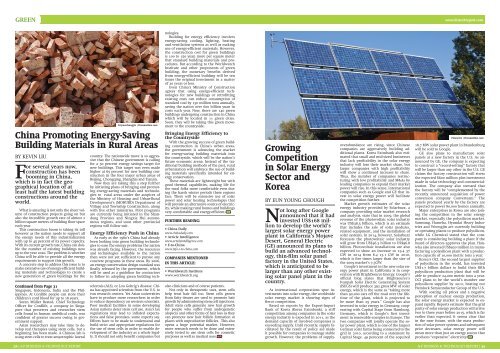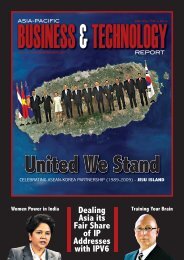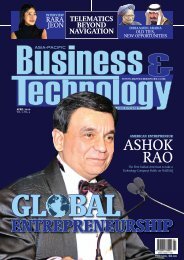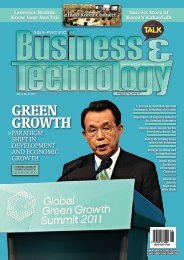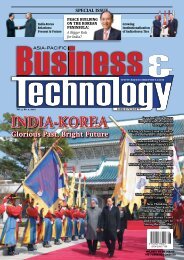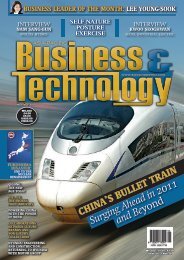Globalization of Korean Cuisine - Asia-Pacific Business and ...
Globalization of Korean Cuisine - Asia-Pacific Business and ...
Globalization of Korean Cuisine - Asia-Pacific Business and ...
Create successful ePaper yourself
Turn your PDF publications into a flip-book with our unique Google optimized e-Paper software.
USINESS www.biztechreport.com<br />
Mobile<br />
Marketing<br />
Trends in <strong>Asia</strong><br />
By AnurADHA SHuKlA<br />
During the past decade,<br />
the world has<br />
witnessed the tremendous<br />
popularity growth <strong>and</strong><br />
influence <strong>of</strong> the Internet <strong>and</strong><br />
other technological innovations<br />
such as mobile multimedia<br />
devices like smartphones,<br />
tablets <strong>and</strong> other<br />
similar high tech gadgets.<br />
Their impact is felt across several industries<br />
<strong>and</strong> in various regions across the globe.<br />
This has resulted in a shift in marketing<br />
strategies with br<strong>and</strong>s, products <strong>and</strong> services<br />
moving away from the costly but less effective<br />
traditional media to the new <strong>and</strong> highly<br />
interactive mobile marketing channels.<br />
There are now more than 4 billion users<br />
<strong>of</strong> mobile phones <strong>and</strong> other similar<br />
internet-ready mobile devices worldwide.<br />
research indicates that 90 percent <strong>of</strong> these<br />
mobile users readily accept <strong>and</strong> read SmS<br />
messages <strong>and</strong> other mobile alerts, making<br />
mobile marketing a very cost-effective way<br />
<strong>of</strong> reaching out <strong>and</strong> interacting with potential<br />
customers. in many parts <strong>of</strong> europe <strong>and</strong><br />
<strong>Asia</strong>, companies have started to adapt mobile<br />
marketing with SmS advertising as its<br />
most popular <strong>and</strong> responsive branch, with<br />
millions <strong>of</strong> advertisements sent every day.<br />
reports from industry experts inmobi<br />
<strong>and</strong> Synovate have indicated a growing<br />
trend <strong>and</strong> reception among <strong>Asia</strong>-<strong>Pacific</strong><br />
consumers in receiving mobile advertising<br />
through SmS messages, text codes <strong>and</strong><br />
mobile ad networks. With smartphone <strong>and</strong><br />
tablet shipments accelerating in shipment<br />
quantities throughout <strong>Asia</strong>, spurred by declining<br />
gadget prices enjoyed by consumers<br />
in various parts <strong>of</strong> the region such as China,<br />
india, indonesia, Thail<strong>and</strong> <strong>and</strong> the Philippines,<br />
mobile marketing will definitely enhance<br />
revenue streams for <strong>Asia</strong>n companies<br />
in 2011 <strong>and</strong> beyond.<br />
mobile marketing Trends<br />
in <strong>Asia</strong> for 2011<br />
According to the mmA, the market is expected<br />
to grow by up to uS$14 billion by<br />
2011, with a huge percentage <strong>of</strong> the revenues<br />
coming from the <strong>Asia</strong> <strong>Pacific</strong> region.<br />
The following describes in brief<br />
the top mobile marketing industry<br />
predictions in the <strong>Asia</strong> <strong>Pacific</strong> region<br />
as recently reported by the mobile<br />
marketing Association (mmA).<br />
• more personalized mobile<br />
marketing messages<br />
– mobile advertising<br />
was previously br<strong>and</strong>ed<br />
as nothing more than<br />
spam on the mobile<br />
phone. Companies then<br />
20 | A-P BuSineSS & TeCHnology rePorT<br />
•<br />
adopted permission-based marketing<br />
to overcome this perception <strong>and</strong> this<br />
was reinforced with the st<strong>and</strong>ardization<br />
<strong>of</strong> regulations. With increased<br />
personalization <strong>and</strong> privacy, mobile<br />
marketing will increase its effectiveness<br />
<strong>and</strong> will continue to grow more<br />
credible among consumers.<br />
Increased data usage with overthe-top<br />
services – revenue focus<br />
by mobile operators will move from<br />
on-deck operator ads to applicationbased<br />
value-added services. Telecom<br />
service providers <strong>and</strong> operators will<br />
make a comprehensive review <strong>of</strong><br />
their existing publishing business<br />
investments <strong>and</strong> will concentrate<br />
more on enabling more devices like<br />
tablets within their networks.<br />
• more free communication channels<br />
across multiple devices<br />
•<br />
– There will be an increase in applications<br />
that will provide free SmS,<br />
free video calls, <strong>and</strong> free phone calls<br />
across multiple mobile device platforms,<br />
with mobile video showing<br />
the greatest increase in consumption.<br />
This free content will be subsidized<br />
by ad units shown on partial but interactive<br />
parts <strong>of</strong> the mobile screen.<br />
windows 7 mobile reborn – The<br />
availability <strong>of</strong> too many phone variants<br />
proved detrimental to the success<br />
<strong>of</strong> Windows 7 mobile, unlike<br />
that experienced by Apple <strong>and</strong> research<br />
in motion (rim), which both<br />
focused more on maintaining strict<br />
hardware specifications. The re-<br />
Yuliya Trukhan | Dreamstime.com<br />
birth <strong>of</strong> Windows 7 mobile will<br />
change all that by using stricter<br />
hardware requirements <strong>and</strong> restricting<br />
use <strong>of</strong> the new oS from phones<br />
that are not compatible.<br />
• hTmL5 versus Apps<br />
– Apps continue<br />
to dominate mobile content<br />
<strong>and</strong> are expected to continue growing<br />
in popularity until 2013. With<br />
the advent <strong>of</strong> HmTl promising great<br />
functionalities <strong>and</strong> opportunities,<br />
apps will be facing stiff competition<br />
from then on.<br />
• Integration <strong>of</strong> Augmented reality<br />
(Ar) <strong>and</strong> Location based Services<br />
(LbS) – gPS <strong>and</strong> digital compass<br />
capabilities in smartphones <strong>and</strong><br />
mobile devices allows for the combination<br />
<strong>of</strong> Ar <strong>and</strong> lBS that will allow<br />
the overlaying <strong>of</strong> real-time graphic<br />
content related to the current geographical<br />
location <strong>of</strong> the user.<br />
• Increased use <strong>of</strong> mobile micropayments<br />
– electronic payment<br />
will now evolve from the use <strong>of</strong> ATm<br />
cards to the use <strong>of</strong> electronic wallets<br />
that are accessible through their<br />
mobile devices, giving users secure<br />
purchase opportunities wherever<br />
they may go.<br />
• mobile blogging renewed – The<br />
capabilities <strong>of</strong> smartphones <strong>and</strong> tablets<br />
make them mini-computers in<br />
their own right, providing writers<br />
<strong>and</strong> bloggers with a writing platform<br />
which they can use to upload<br />
content to their websites even while<br />
on the go.<br />
• more browser-capable mobile<br />
devices – experts predict that 85<br />
percent <strong>of</strong> mobile devices that will<br />
be shipped in 2011 will already have<br />
browser capabilities. more users can<br />
now view richer content on these<br />
devices, making them an effective<br />
medium for marketers.<br />
• Enter mobile 3D – 3D technologies<br />
have also grown into popularity<br />
now that more gadgets are moving<br />
towards incorporating these technologies,<br />
<strong>and</strong> these include mobile<br />
devices. Although a practical <strong>and</strong><br />
usable device may not be available<br />
this year, there surely will be a lot<br />
<strong>of</strong> experimentation in this area from<br />
several providers <strong>and</strong> operators. a-p<br />
FURThER READING:<br />
• Mobile Marketing Association<br />
www.mmaglobal.com<br />
• <strong>Asia</strong> Telecom News<br />
www.asiatelecomnews.com<br />
• iMedia Connection<br />
www.imediaconnection.com<br />
COMPANIES MENTIONED<br />
IN ThIS ARTICLE:<br />
• Apple<br />
www.apple.com<br />
• InMobi<br />
www.inmobi.com<br />
• Synovate<br />
www.synovate.com<br />
E-Vehicle Push<br />
in <strong>Asia</strong>-<strong>Pacific</strong><br />
By KeVin liu<br />
When Chinese Premier<br />
Wen Jiabao<br />
pledged his country’s<br />
commitment to save<br />
energy <strong>and</strong> clean up the<br />
environment, he not only<br />
expressed China’s commitment<br />
to respond actively to<br />
impacts caused by climate<br />
change but the whole <strong>Asia</strong>-<br />
<strong>Pacific</strong> region’s commitment<br />
as well.<br />
Spearheaded by China’s goal to reduce<br />
carbon emissions by 40 percent by the year<br />
2020, most developing countries in the region<br />
have also expressed their role in saving<br />
energy <strong>and</strong> reducing harmful emissions.<br />
in a bold move, many <strong>Asia</strong>n economies<br />
have aggressively made headway into the<br />
adoption <strong>and</strong> mass utilization <strong>of</strong> various<br />
kinds <strong>of</strong> e-vehicles. many <strong>of</strong> these countries<br />
have tapped both foreign <strong>and</strong> local developers<br />
<strong>and</strong> manufacturers to build e-vehicles<br />
that are unique to the country’s transportation<br />
culture. Such strategies are effective in<br />
facilitating faster assimilation <strong>of</strong> e-vehicles<br />
into mainstream usage, <strong>and</strong> with government<br />
support could provide a significant<br />
impact in reducing the pollution caused by<br />
conventional transport systems <strong>and</strong> reduce<br />
these countries’ dependency on petroleum<br />
products.<br />
Updates on E-Vehicle Adoption<br />
<strong>and</strong> Use in <strong>Asia</strong>n Countries<br />
The following describes current inroads<br />
made in various countries in the <strong>Asia</strong>-<strong>Pacific</strong><br />
region with their adoption <strong>and</strong> use <strong>of</strong><br />
e-vehicles as a clean alternative for conventional<br />
transportation.<br />
• philippines – As one <strong>of</strong> the most<br />
oil-dependent countries in <strong>Asia</strong>, the<br />
Philippines is taking steps to address<br />
this ever-growing dependence on<br />
fossil fuels as more households, factories<br />
<strong>and</strong> transportation increase in<br />
number. Working with the <strong>Asia</strong>n Development<br />
Bank (ADB), the electric<br />
Vehicle Alliance <strong>of</strong> the Philippines<br />
(eVAP), <strong>and</strong> the Congressional Commission<br />
on Science <strong>and</strong> Technology<br />
<strong>and</strong> engineering (ComSTe), they<br />
have collaborated in the deployment<br />
<strong>of</strong> 20,000 electric tricycle units<br />
in various locations across the country.<br />
This is part <strong>of</strong> the bigger move<br />
by industry players <strong>and</strong> government<br />
agencies to further develop the evehicle<br />
industry in the country with<br />
the development <strong>of</strong> green transport<br />
systems that will include the electric<br />
tricycle, hybrid jeepneys, electric<br />
buses <strong>and</strong> electric bicycles.<br />
• Singapore – The preferred green<br />
vehicles in this country include the<br />
hybrids <strong>and</strong> the Compressed natural<br />
gas (Cng) vehicles. According to the<br />
Singapore l<strong>and</strong> Transport Authority<br />
(lTA), there are more than 2,462<br />
hybrids, 4,473 bi-fuel Cngs <strong>and</strong> 26<br />
pure Cngs registered in the country.<br />
To further improve the number <strong>of</strong><br />
green vehicle adoption, the country<br />
has implemented the green Vehicle<br />
rebate (gVr) scheme which will<br />
Olga Besnard | Dreamstime.com<br />
•<br />
provide buyers with a 40 percent<br />
rebate based on the vehicle’s open<br />
market value. Further development<br />
<strong>of</strong> e-vehicles is also being pursued<br />
<strong>and</strong> spearheaded by a government<br />
multi-agency taskforce headed by<br />
the energy market Authority (emA)<br />
<strong>and</strong> the lTA, with car manufacturer<br />
renault-nissan signing up <strong>and</strong> participating<br />
in this program to provide<br />
e-vehicles to the public.<br />
Thail<strong>and</strong> – Just like any other country<br />
in <strong>Asia</strong>, Thail<strong>and</strong> is also faced<br />
with the problems brought about by<br />
rising oil prices, compounded by the<br />
resulting pollution from petroleumbased<br />
fuels. The government initiated<br />
its own e-vehicle policy called<br />
e-Co Car, with electric vehicles limited<br />
to sizes ranging between 1.32<br />
meters wide <strong>and</strong> 3.6 meters long. At<br />
the forefront <strong>of</strong> this development<br />
is Thail<strong>and</strong>’s Clean Fuel energy enterprise<br />
Co. ltd., a company developing<br />
<strong>and</strong> researching equipment<br />
<strong>and</strong> weaponry for the royal Thai Air<br />
Force. The company has now produced<br />
several electric powered vehicles<br />
powered with batteries which<br />
are currently being used in large industrial<br />
estates, hotels, resorts, golf<br />
courses <strong>and</strong> other tourists areas vital<br />
to the country’s economy.<br />
• India – The indian government<br />
has recognized the importance <strong>of</strong><br />
promoting electric vehicles <strong>and</strong> has<br />
mobilized the national Council for<br />
electric mobility (nCem) <strong>and</strong> the<br />
national Board for electric mobility<br />
(nBem). These agencies will spearhead<br />
the development <strong>and</strong> promotion<br />
<strong>of</strong> hybrid <strong>and</strong> electric vehicles to<br />
reduce the country’s dependency on<br />
Continued on Page 25<br />
A-P BuSineSS & TeCHnology rePorT | 21


